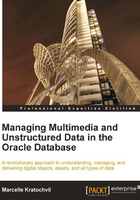
Preface
Digital data can be broken down into structured and unstructured data. Unstructured data outweighs structured by 10 to 1. The most well known unstructured data type is multimedia, which comprises digital images, audio, video, and documents.
For a very long time the topic of unstructured data and managing it has been pushed to the side lines and given the label of being just too hard to deal with. More time and attention has been given to relational data, which has been analyzed, conceptualized, and understood since it was first mathematically defined in the 1970s. Since then the market has changed. New technologies have introduced new rules and requirements for dealing with unstructured data. Structured data, which has been leading the market as a subset called relational data, shows to have limitations. It cannot encompass, correctly describe, and manage the large variety of multimedia types appearing in the market. The move to adapt to new technologies that interface more directly with people has shown that smart media is friendlier and easier to understand.
With the iPhone, iPad, Android, and equivalent smart devices now proliferating in the market, the whole world has been given access to computers. Sidelined are the complex, virus-prone PCs that a large number of people could never comprehend or correctly use. The multimedia centric iPad is a device that most people can learn in minutes and master in under an hour. The keyboard is nearly gone and digital images, video, and audio give a richer, entertaining, and a more productive environment to work in.
Structured data isn't gone. Its importance cannot be overlooked. It is just not the dominant data structure anymore that we have been taught to believe. What is yet to be realized when it comes to the future of computer human interfaces, is that its existence is really there to support unstructured data. To give it extra meaning and to enhance its use. The key factor to realize and what this book will show, is that structured data is not the pinnacle of data management. It has an important role, but its role is to provide a solid foundation and core base for which unstructured data can work on.
The aim of this book is to try and give a basic understanding to a lot of concepts involving unstructured data. Particular focus is given to multimedia (smart media or rich media). This is the most popular and well understood subtype of unstructured data in the market place today. The book will cover key concepts from first principles. Later chapters are designed for database administrators though developers and storage architects can gain a good understanding on the key concepts covered. An attempt has been made to future proof some chapters so that as technology changes, the core concepts can be remolded and adapted to meet those changes. Where areas are deemed immutable, they are highlighted so the reader can be aware that these ideas can become dated or need to be reviewed to assess their validity as technology changes.
This is the first of two books in the series. The first book is designed for technology architects, managers, and database administrators. The second book will focus on developers and storage architects. It will cover methods for building multimedia databases and techniques for working with very large databases.
This book uses the Oracle 11g R2 database as the core database. Special sections are devoted to adapting the concepts covered for the Oracle 11 XE release.
Some of the chapters draw citations from Wikipedia. These citations are additional to the ones provided and are there for those who make extensive use of Wikipedia. In a number of cases the citations given are to highlight that useful information is found at the site rather than justifying a particular claim. As the topics covering multimedia are very new and in some cases have only been released in the last one to two years, the most accurate and up to date information on them can be found at the Wiki site.
The exercises found at the end of each chapter are purposely designed so that the answers to them are not found in the book or on the Internet. The lessons and techniques gained from reading the chapter will provide the necessary solution to each exercise, but the reader will need to use their skill and experience to correctly determine the answer. All exercises have valid answers but they are deliberately not included. Answers will be provided in the second book. This book will cover developer and programming topics, disk storage and techniques for integration of multimedia using a variety of programming tools, including Java, PHP, C, C++, Perl, Python, Ruby, PL/SQL and Visual Basic.